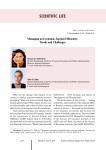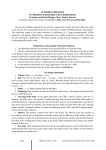Economic and Social Changes: Facts, Trends, Forecast @volnc-esc-en
Статьи журнала - Economic and Social Changes: Facts, Trends, Forecast
Все статьи: 1728
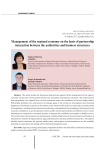
Статья научная
The article studies the theoretical and practical aspects of the management of the region’s economy on the basis of interaction between the authorities and business structures. The authors prove that partnership is an optimal form of such interaction under the conditions of chronic budget deficit. Partnership facilitates the achievement of strategic goals of the territory’s development and structural adjustment of domestic economy; it also enhances the interest of the parties in achieving successful results of cooperation, and helps attract innovation technology and significant extra-budgetary investments in the economy. In addition, as world experience shows, public-private partnership is an effective tool to remove infrastructure constraints to economic growth, to improve the availability and quality of public services. The article shows that at present the development of partnership between the government and business is hindered by a number of organizational, legal and financial-economic problems and barriers. The authors identify priority directions for regional public policy and propose several measures to use the available potential of cooperation for dealing with territorial development issues.
Бесплатно

Management of vertically integrated systems formation and development in the Russian economy
Статья научная
The article reviews the essence, nature, features and basic approaches to the interpretation of vertical integration. It proves that one of the key conditions for modernizing and neo-industrializing domestic economy and transforming Russia into an industrialized country is overcoming technological fragmentation of business entities, as was the case in the Soviet Union and is now observed in the developed countries. In this situation, it is vertical integration which can ensure the diversification and restructuring of the economy, the linkage between the extractive and processing industries. Based on the results of analyzing the activities of major multinational corporations (Royal Dutch Shell, Sinopec Corp., Valio Ltd. etc.) it has been proved that these integrated systems supply competitive products with high degrees of processing and serve as growth drivers in developed economies. To justify this, the author calculated the companies' value added multiplier. Currently, vertically integrated systems such as PhosAgro PJSC, LUKOIL PJSC, Miratorg agro-industrial holding company, KamAZ OJSC, Arkhangelsk pulp and paper mill PJSC operate in various economic sectors...
Бесплатно
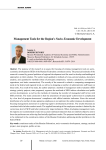
Management tools for the region's socio-economic development
Статья научная
The purpose of the research is to assess the focusing of existing management tools on socio-economic development (SED) of the Russian Federation constituent entity. The practical rationale of the research is caused by general problems of regional development and the need to develop methodological approaches to their solution. The author used qualitative methods of cross-sectoral analysis, document analysis, and quantitative methods (those of principal components, variance calculation, correlations, regressions, and index construction). The novelty of the research is related to comparing management tools at the federal and regional levels, as well as to designing a number of administrative staff based on these tools. As a result of the study, the author proposes a method of management tools evaluation (SED strategy, priority projects, state programs), approves the methods of SED indices calculation and public services development, as well as the methods of rationing the number of managerial staff in line with SED priorities. The main conclusion is that the assessment of stated goals’ achievement is complicated by a low level of program documents’ compliance with official statistics indicators. Since the sectoral distribution of a number of state apparatus employees is not optimal, the author proposes its adjustment, focusing management personnel on achieving region’s development priorities. The results obtained are correlated with the labor market trends. The applied forecasting of the employees number is limited by the correctness level of SED and labor productivity target indicators. When developing management tools, the regions are recommended to take into account statistical indicators that are relatively objective and to focus the performers on achieving final socially significant results. The proposed method has the potential to be replicated in the constituent entities of the Russian Federation addressing similar problems in the field of SED.
Бесплатно

Managing agglomeration development in the face of multiple competing goals: challenges and solutions
Статья научная
The emergence of agglomerations as new objects in the public administration system makes it necessary to create and define a set of indicators that will assess their economic growth and development. This management problem justifies the relevance of the study, the aim of which is to assess the information and analytical sufficiency and quality of indicators recommended for use in the elaboration of longterm plans for the socio-economic development of large and largest agglomerations and determined by documents of strategic planning at the federal level, using the example of the Saint Petersburg agglomeration. The methodological basis of the research includes the publications of Russian and foreign scientists and experts on the problem of spatial development and management of urban agglomerations; the current legal framework regulating certain aspects of the national spatial development policy; official statistics data. Based on the results obtained during the study, the following conclusions are drawn: 1) indicators for assessing the economic growth of agglomerations, which are unambiguously defined by federal documents of strategic spatial planning, can be accepted as minimally sufficient and exclusively for the implementation of an extremely concise version of express analysis; 2) the process of institutionalization of urban agglomerations management has not been completed; at the current stage, we are dealing with a “soft” form of both requirements for determining the composition and boundaries of agglomerations and rules for the formation of long-term agglomerations development programs; 3) it is necessary to develop existing experience in creating strategic plans for the development of urban agglomerations. The new methodology should combine modern spatial development concepts that help to find a compromise between state control and the potential of agglomeration management; to overcome the problem of fragmentation of management and the blurring of the institutional structure of agglomeration management; to use the tools of quality economics (metrology, standardization and quality management) in the development of strategies and long-term plans for the development of urban agglomerations.
Бесплатно
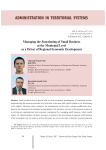
Статья научная
Small business plays a special role in socio-economic development of territorial entities. Implementing the resource potential of a local area is the main and typical feature in the functioning of its subjects. However, issues related to the management of the sector, remain insufficiently developed in the framework of individual municipalities. On this basis, the aim of the present research is to develop an organizational and economic mechanism for managing small business, which would ensure the implementation of policy measures to enhance the functioning of regional small business at the municipal level. In order to achieve this goal, we set out the tasks to develop recommendations to promote the work of small organizations with the help of program activities and organizational and economic mechanism to ensure their implementation, as well as recommendations for the calculation of their economic effects. Methodological approaches to the research are based on general scientific methods (comparison, generalization, analysis, synthesis) and statistical methods (correlation, regression analysis)...
Бесплатно
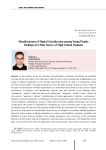
Статья научная
In the modern world, the processes of socialization (personality formation) are gradually moving from the real world to the online space. However, due to the increasing risks of digitalization, the impact of digital socialization on the younger generation becomes an object of controversy among scientists and the public. The paper proposes our own two-stage typology of Internet users, based on the signs of manifestation of online temperament as a behavioral model formed in the course of digital socialization. According to the classification, Internet users have features of the following types: “opportunist / idealist” (using the Internet for deception), “enthusiast / skeptic” (trust / distrust of the content), “aggressor / tolerant” (manifestation of online aggression), “addictive / autonomous” (presence of Internet addiction). Combinations of features of particular types make up the general types of users (adaptive, substitutional, passive), which reflect the results of digital socialization and network acculturation. We propose an algorithm for identifying the types of Internet users in the course of a sociological study. Having tested the proposed solution within the framework of an intelligence study (in the case of a pilot group of schoolchildren from the city of Vologda) we formulate working hypotheses about the diverse impact of digital socialization on modern schoolchildren; dynamics, instability and flexibility of online behavior models of the younger generation; close connection of the socializing influence of the Internet with the development of interpersonal communication. The hypotheses will be taken into account in the course of elaboration of the research topic. The article puts forward a model for organizing digital socialization based on the harmonization of interests of the widest possible range of agents. The findings of the research can be used in the formation of strategic plans for the development of the digital industry and educational policy. Scientific novelty of the research consists in the development of a new methodological solution for using the socializing influence of the Internet environment in the process of generalization.
Бесплатно

